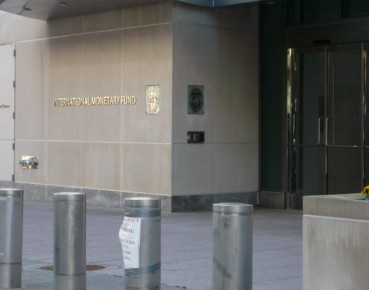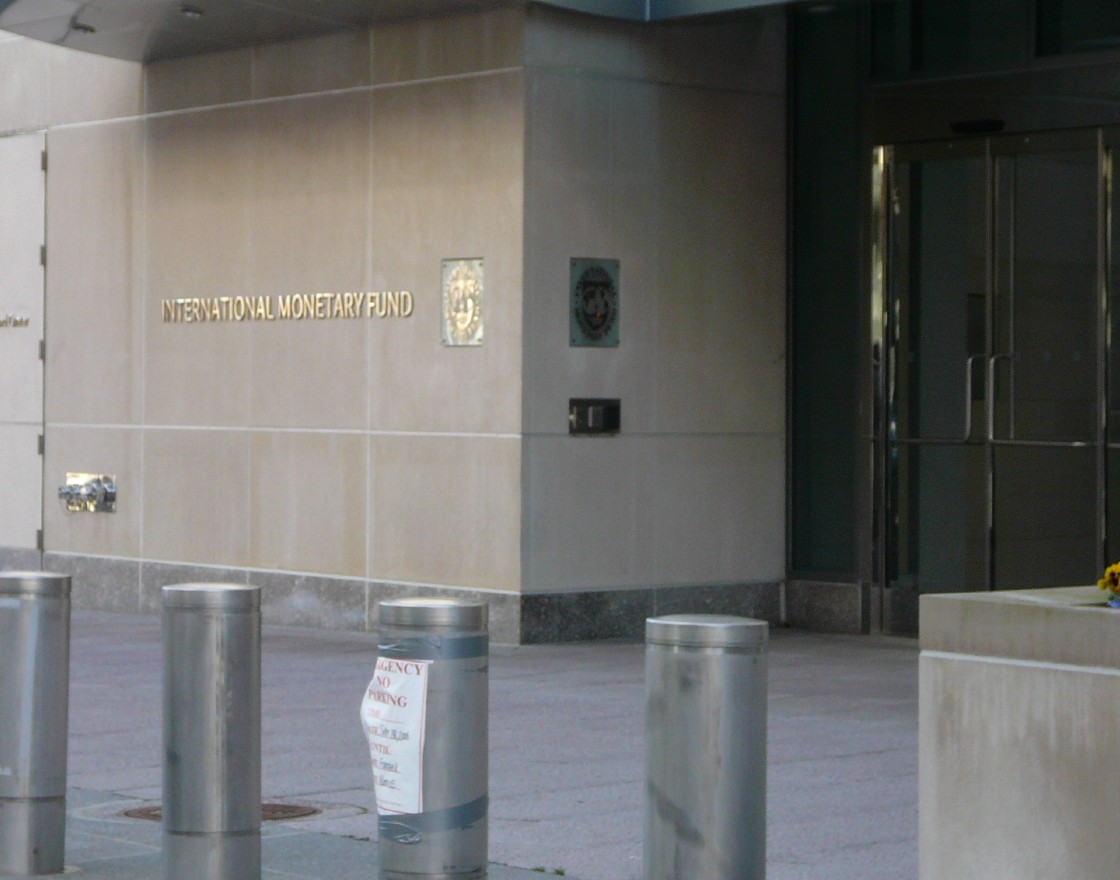Tydzień w gospodarce
Category: Trendy gospodarcze

IMF headquarters, Washington DC, USA (E. Strathmeyer, CC BY-NC-ND)
Kristalina Georgieva, the Managing Director of the IMF, announced in the first weeks of the pandemic that the Fund was willing to use all of its lending capacity, reaching approximately USD1 trillion, to meet the increased borrowing needs of the member countries. In her opinion, the intensive cooperation of the international community and international financial institutions is necessary in order to overcome the crisis caused by the coronavirus and to build the foundations for a quick economic recovery.
Ms. Georgieva determined that this cooperation should be focused, among other things, on providing quick and effective assistance for the developing countries, which are the most vulnerable to the health, economic and social impact of the pandemic, and which have limited funding opportunities in the financial markets, as well as for the emerging economies, which are experiencing the outflow of capital on a huge scale.
In light of the unprecedented nature of the COVID-19 crisis and the exceptionally high uncertainty regarding its duration, and the scale of its consequences, the main priority of the actions taken by the IMF was to provide the member countries (and in particular the low-income ones) with access to emergency funding — within the framework of the Rapid Credit Facility (RCF) and Rapid Financing Instrument (RFI) programs. These funds were to be used in order to meet urgent balance-of-payments needs, without the need to agree on a program of reforms and without ex-post conditionality. The Fund also continues to support member countries using instruments such as the Stand-By Arrangement (SBA), the Stand-By Credit Facility (SCF), the Extended Fund Facility (EFF), and the Extended Credit Facility (ECF).
It should be noted, however, that in conditions of increased uncertainty it may prove necessary to change the financial support programs agreed between the IMF and the individual member countries prior to the outbreak of the pandemic, in order to adapt them to the conditions of the COVID-19 crisis. These adjustments could involve, i.a., a possible increase in the amounts of the previously granted funds under the SBA, SCF, the EFF and ECF instruments, changes in the disbursement dates of the subsequent tranches of the loan funds, and the development of contingency plans in the countries’ economic policies in case the adverse macroeconomic scenarios begin to materialize.
In order to adapt the Fund’s instruments to the scale of the COVID-19 crisis, in April the IMF Executive Board approved a temporary (effective for 6 months) increase in the access limits to emergency funding. The annual access limits to financing under the regular window of the RFI and the exogenous shocks window of the RCF that IMF member countries may apply for were increased from 50 to 100 per cent of the membership quota, and the cumulative limits were increased from 100 to 150 per cent of the membership quota, net of the scheduled repayments or repurchases. At the same time, the administrative procedures concerning the applications for funding under the RFI and RCF were greatly simplified in order to ensure that they can be approved more swiftly by the IMF Executive Board. The total amount of assistance that IMF provided (as of July 2020) to 72 member countries, in the form of emergency financing instruments or increases in the amounts of financing agreements between the Fund and individual countries which were effective prior to the outbreak of a pandemic, amounts to approximately SDR18.5bn (approximately USD25.3bn).
When deciding on the temporary increase of the access limits for emergency financing the IMF Executive Board determined that the nature of this emergency financing provided by the Fund should be “truly additional”. This applies both to the funds from the General Resources Account (GRA), which is used in the financing of the loan support provided under the SBA, SCF, EFF and ECF instruments, as well as the funds accumulated in the Poverty Reduction and Growth Trust (PRGT), which is designated for the provision of interest-free loan support to low income countries. The Executive Directors also emphasized that IMF emergency funding serves the role of a catalyst accelerating the acquisition of additional financial support from other sources.
As part of the response to the COVID-19 crisis, the Executive Board also approved the allocation of grants from the Catastrophe Containment and Relief Trust (CCRT) for the poorest member countries. As of July 2020, the 6-month grants from the CCRT were received by 27 member countries of the IMF: Afghanistan, Benin, Burkina Faso, Democratic Republic of the Congo, Djibouti, Ethiopia, Gambia, Guinea, Guinea-Bissau, Haiti, Yemen, Comoros, Liberia, Madagascar, Malawi, Mali, Mozambique, Nepal, Niger, Central African Republic, Rwanda, Sierra Leone, Tajikistan, Tanzania, Togo, Solomon Islands, São Tomé and Príncipe. These grants will be used to finance the servicing of these countries’ debt towards the IMF in 6 months, that is, from April to October (with a possible extension to two years, depending on the availability of the funds accumulated on the CCRT). The total amount of funds released through the grants is SDR177.65m (approximately USD243.61m).
The IMF has also become involved in the efforts to mitigate the problem of growing debt of the individual member countries. As part of these activities the IMF in cooperation with the World Bank provided support to the G20 Group with regard to the Debt Service Suspension Initiative. Pursuant to this project the official bilateral creditors suspend the servicing of debt owed by the poorest countries, benefiting from the support of the International Development Association. The involvement of G20 countries in the implementation of the Debt Service Suspension Initiative will allow the beneficiaries of the International Development Association to keep a total amount of over USD11.5bn in their national budgets (as of July 2020). The Managing Director of the IMF, the President of the World Bank and the representatives of the G20 countries called on private creditors to adopt a similar initiative, which could allow for freeing up an additional amount of USD7bn for the poorest countries in the world.
One of the elements of the IMF’s strategy during the COVID-19 crisis is also to provide member countries with prudential support, available under the Flexible Credit Line (FCL) and the Precautionary and Liquidity Line (PLL). The FCL is an instrument designed for the benefit of member countries with strong macroeconomic foundations and stable economic policy frameworks. Its goal is to prevent crises and to protect economies against external shocks by providing access to the Fund’s considerable financial resources with no ex-post conditionalities.
Prior to the outbreak of the pandemic, 2-year agreements on access to the FCL were signed by Colombia for the amount of SDR7.848bn (approx. USD10.8bn) and Mexico — SDR44.563bn (approx.USD61.4bn). In response to the request of the Colombian authorities, in May the IMF Executive Board provided Colombia with access to the FCL for two more years, that is, until April 2022 (at unchanged access levels). In addition, at the end of May 2020 2-year arrangements for access to financing under the FCL amounting to SDR8bn (approx. USD11bn) and SDR17.44bn (USD23.93bn), respectively — were approved for two other Latin American countries: Peru and Chile. Thus far, none of the abovementioned countries have used the funds made available under the FCL.
On the other hand, the PLL is an instrument for countries that do not meet the demanding criteria for access to FCL. In contrast to the FCL, the countries wishing to benefit from the funds made available under the PLL are obliged to accept the conditions set out by the IMF concerning the evaluation of their budgetary and financial policy.
At present, only Morocco has access to the PLL (awarded in December 2018, for a period of two years, and for the amount of SDR2.15bn, approx. USD2.97bn). In light of the COVID-19 crisis in April 2020 the Moroccan authorities decided to draw on the funds made available under the PLL. The funds from the PLL were allocated for measures aimed at limiting the social and economic impact of the COVID-19 pandemic and allowed Morocco to maintain an adequate level of official foreign reserves.
Pursuant to the decision of the IMF Executive Board, a new instrument was created for countries with strong economic foundations — the Short-Term Liquidity Line (SLL). Under it the approved member countries may access a revolving line of liquidity in the amount of up to 145 per cent of a country’s membership quota in the IMF. The SLL is intended to provide liquidity support in situations of potential, moderate, short-term balance of payment needs, manifested by capital account pressures and pressure on the level of international reserves, and resulting from instability in the international capital markets. The aim of SLL is to minimize the risk of liquidity shocks evolving into deeper crises and spilling over to other countries. The SLL was established for 7 years, with an expectation that, by end‑2025, the Executive Board will decide whether to extend the facility beyond 2027. So far (as of July 2020) the IMF hasn’t granted access to the SLL to any member country.
The involvement of the IMF — as the central institution of the global financial safety net — constitutes significant support for the fiscal and monetary policies implemented in the member countries. The priority treatment of the poorest and least-developed countries, whose macroeconomic situation further deteriorated as a result of the pandemic, deserves to be praised.
The IMF’s increased lending activity entails the increased use of its resources, which primarily consist of members’ quotas (in a total amount of SDR320bn, that is USD440bn), followed by funds — amounting to SDR143bn (USD193bn) and SDR250bn (USD344bn), respectively — secured within the framework of the New Arrangements to Borrow (NAB) and the Bilateral Borrowing Agreements (BBA), which are activated after the fulfillment of certain conditions and after approval of the participants of these agreements. This means that alongside its effort to meet the increased borrowing needs of the member countries the IMF Executive Board is also acting to secure the Fund’s lending capacity at least at the current level of approximately USD1 trillion.
In its efforts to support the member countries in the fight against COVID-19, the IMF emphasizes that measures aimed at reducing the effects of the pandemic and at promoting the fastest possible economic recovery must take into account issues such as climate protection and the development of the low carbon economy, which have been neglected for many years. Moreover, in light of the dynamic development of the digital economy, the Fund recognizes the need to ensure that the benefits of digitization and the development of new technologies are available to the highest possible number of countries and societies. According to the IMF, it is also important to counteract the increase in income inequality, to ensure equal access to education, and to expand welfare programs dedicated to the most vulnerable social groups. It is still an open question, however, whether the countries benefiting from the financial assistance provided by the Fund will include these proposals in their economic policies.
The views expressed in this article are the private views of the author and are not an expression of the official position of the NBP.

